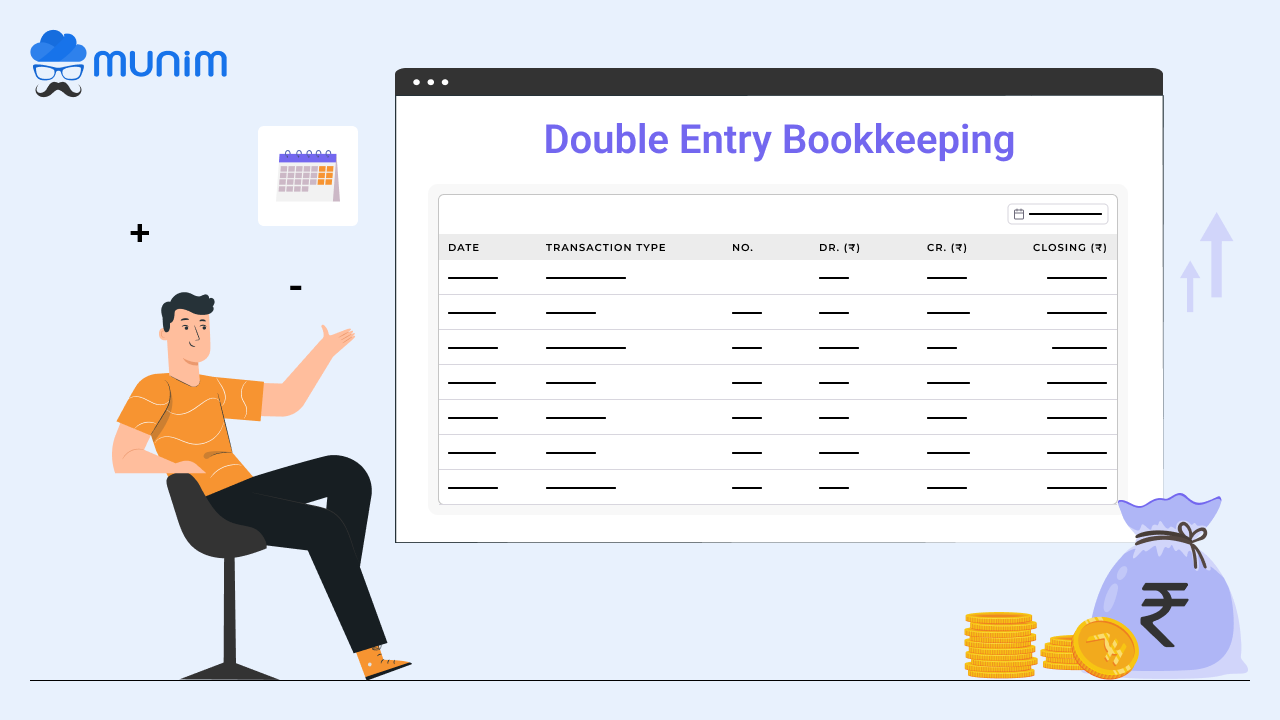Everything You Should Know About Double Entry Bookkeeping

One of the fundamental laws of Physics namely Newton’s 3rd law of motion, states that ‘every action has an equal and opposite reaction’. The application of this law is extended to bookkeeping as well. Perplexed, right? You must be thinking that we are a lost cause, but we aren’t. Whether you have a startup, entrepreneur or a large enterprise. Let us have the privilege of proving the claim right. Suppose you lend me Rs. 500, this transaction will be debited from your books of accounts and credited to my books of accounts. As you can see, this transaction has an equal and inverse effect in the accounting books. There are three methods to record transactions, and one of them is double-entry bookkeeping.
In this blog, we will discuss the double-entry bookkeeping system along with its rules, advantages, and requirements. Read further to know more!
What Is Double Entry Bookkeeping?

Double-entry bookkeeping is an accounting process in which transactions are maintained in two or more accounts with the use of debit and credit entries. Under this method, each transaction will have the opposite effect on the other account, and also the total of both accounts would be equal.
Let’s understand with an example.
A businessman bought a machine worth Rs. 100,000 for his business. He credits Rs. 100,000 in the expense account and debits Rs. 100,000 from the cash account. In other words, the debit in one account would be balanced out with credit in the other account. Now his expense stands at Rs. 100,000 and Rs. 100,000 less in cash.
Rules Of Double Entry Bookkeeping?
The following are the major rules of the double-entry system:
- Every accounting entry should be recorded in at least two accounts in the books.
- The sum of all the debits and the sum of all credits must be equal.
- The total assets should be equal to the sum of the total liabilities and equity of your business. (Assets = Total Liabilities + Equity)
Importance Of Double Entry Bookkeeping

Most Small businesses maintain single-entry bookkeeping. In the following section, we will discuss the importance of double-entry bookkeeping and why you should implement the same.
Easy To Find Errors
The thumb rule of double-entry bookkeeping is that assets should be equal to the sum of liabilities and equity. If this principle does get fulfilled then there would be errors in entries. One can know whether the accounts are accurate or not by just looking at the total. And is one of the reasons why one should migrate to this method of bookkeeping.
If you think that this method of bookkeeping is difficult to maintain manually, in that case, we have a solution for you – Munim. Try using it and we are sure you will realize the ease of handling books of accounts.
Good For Seeking a Loan Or Investment
As the double-entry accounting system is more transparent and holistic, banks and investors providing you funds for business will require books of accounts drafted in this system to make investment decisions.
Enable Companies To Make Data-Backed Decisions
Since double-entry accounting statements are enough to know whether a company is profitable or not and how strong its performance is, you can get an idea of how much money is spent compared to the revenue generated.
This data-rich information enables you to make informed decisions regarding resource allocation and debt management.
Advantages Of Double Entry Bookkeeping

The following are the benefits of the double-entry bookkeeping system:
Easier Auditing: Auditing books of accounts gets easier with double-entry bookkeeping since it is effortless to draft balance sheets and P&L statements.
Efficient Method – The double-entry bookkeeping method records transactions side-by-side, helps business owners keep track of cash flow, and enables easy preparation of quarterly/yearly financial statements.
Accuracy – Since there are two entries made for each transaction so chances of error are minimal.
Analysis – As there are two sides of a transaction, side-by-side, it is easy to tally the entries with just a glimpse.
Requirements Of Double Entry Bookkeeping
Let’s look at the requirements of a double-entry bookkeeping system in detail:
Double Entry Journal
A journal records the flow of money in a business. While maintaining a journal, ensure that the transactions are recorded in the order of events and that dates are also mentioned against each transaction along with the purpose of each transaction.
However, balancing debits and credits is outside the scope of this accounting activity.
Ledger
There are different types of ledgers. Some of them do not carry forward balances from the previous financial year, while others do. If the journal entries are not separated, you would have to organize them as per the balancing formula
Financial Statements
It is a kind of report of all the transactions that took place in a quarter/year. This document dictates the overall performance of your company in a given period. With Munim – online accounting software, you can generate financial statements for your company with just a click.
Summing Up
So this was all you need to know about the double-entry bookkeeping system. We hope that after reading this article, you will switch to double-entry accounting. In case you get overwhelmed with manual double-entry accounting, you can try Munim, an online accounting software in India. Try it free for 14 days; no credit card is required. We can assure you that your accounting and compliance will be super easy with our software.
FAQs On Double Entry Bookkeeping
Q. What are various methods of bookkeeping?
Ans. Following is a list of different methods of bookkeeping:
- Single entry bookkeeping
- Double entry bookkeeping
- Cash-based or accrual bookkeeping
Q. What are the two different types of entries in double-entry bookkeeping?
Ans. There are two types of entries in double-entry bookkeeping: debit and credit. Each journal entry is updated in at least two accounts; that’s why it is known as a “double-entry account.”
Q. What is a contra account?
Ans. A contra account is used to decrease the value of the concerned account when both are netted together. The balance of a contra account is always the opposite of the concerned account.






